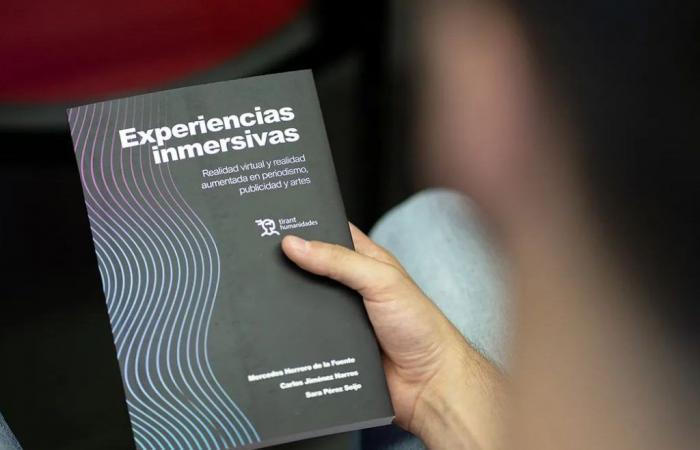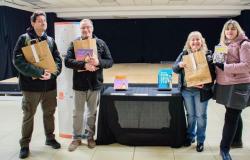
Technological innovation multiplies the possibilities of telling a story as if the recipient were experiencing it first-hand. Virtual reality (VR) and augmented reality (AR) produce novel narratives, which are increasingly present in journalism, advertising and the arts. The user experience is transformed thanks to the immersive nature of new devices and their possibilities for interaction. All of these tools will grow even more in the coming years.
This is the thesis of the book Immersive Experiences. Virtual reality and augmented reality in journalism, advertising and arts (Editorial Tirant Lo Blanch), coordinated by researchers Mercedes Herrero de la Fuente and Carlos Jiménez Narros (Nebrija University), together with professor Sara Pérez Seijo (University of Santiago de Compostela) , and in which 44 authors participate in 18 chapters. In addition to professors from 14 universities, the collective work integrates voices from professionals in the media, marketing, and visual and performing arts, “who provide a practical look at the advancement of these technologies.”
The book, in addition to laying the theoretical foundation, shows the current state of new immersive technological procedures: documentary, binaural, sports content, serious games (journalism); extended reality glasses, phygital -fusion of virtual and digital elements in the physical environment- outdoor advertising and metaverse (advertising); and spatial computing -use of computer technology to interact with the physical world in three dimensions- (art). It even includes a chapter on immersive experiences on the ground in militarized zones.
Examples of these practices
Immersive experiences. Virtual reality and augmented reality in journalism, advertising and arts, with a cover designed by Miguel Ángel Ruiz Peinado, also explains the new concepts with practical examples such as Cuarta Pared VR, for immersive theater, or Nebrija: wake of the letters, a virtual experience that accompanied the visitors to the exhibition of the V Centenary of the death of Antonio de Nebrija.
The comprehensive project of delimiting the immersive experiences in these three fields in a single volume arose in the Faculty of Communication and Arts of the Nebrija University, as a proposal by Mercedes Herrero de la Fuente and Carlos Jiménez Narros, who had previously published several articles on the subject in indexed Spanish and foreign magazines on immersive experiences. His research has focused on the field of journalism and television, specifically on Antena 3, Radio Televisión Canaria and TVE. Afterwards, both researchers contacted Sara Pérez Seijo, an expert in immersive journalism.
Foreword by journalist Eva Dominguez
The prologue is given by Eva Domínguez, journalist, researcher, professor and consultant in immersive narratives and author of the podcast Creaturas immersivas, a space for reflection on the path towards the three-dimensional internet. In 2013, Domínguez published the first doctoral thesis on immersive journalism in Spain.
“The digital world is gaining in hyperrealism and is going beyond the limits of screens or the feeling that we are in front of them. Augmented reality and mixed reality, instead of replacing our perception of the world with a digital representation, hybridize the digital and the physical. We can tell stories that take place in specific locations. Giant characters on top of buildings, or that come out of shop windows and move through the streets,” he writes in the prologue.
Eva Domínguez believes that “the possibilities for narratives in any field are expanding and, at the same time, they test what we know about how to articulate stories and connect with hyperconnected audiences,” but “we need boundaries that allow us to maintain the connection with the real and fictitious world, which protect us from confusion and allow us to develop critical sense.”
Expert debate
At the book presentation at Nebrija University, Mercedes Herrero moderated a round table that included Paco Asensi, an expert in immersive narratives, member of Audiovisual Innovation and professor of the Master in Journalism and Sports Broadcasting at Nebrija; Alejandro Báguena, CEO and founder of Onirica VR; and Javier de la Vara, a publicist specializing in immersive experiences and creative at Pernod Ricard.
The three cited more immersive examples that enriched the debate: the Paris Olympic Museum, Fukushima Video 360 VR or the Roblox video game platform. In addition, they referred to technologies such as Apple’s Vision Pro glasses or the metaverse. According to Javier de la Vara, we will have to wait ten or fifteen years to see the massive reach of Visión Pro in advertising campaigns.
Paco Asensi and Alejandro Báguena agreed that we will increasingly coexist with the metaverse or its different modalities. “Virtual and augmented reality has been killed and resurrected countless times, but the evolution is upward and companies are betting on them,” said Báguena.





